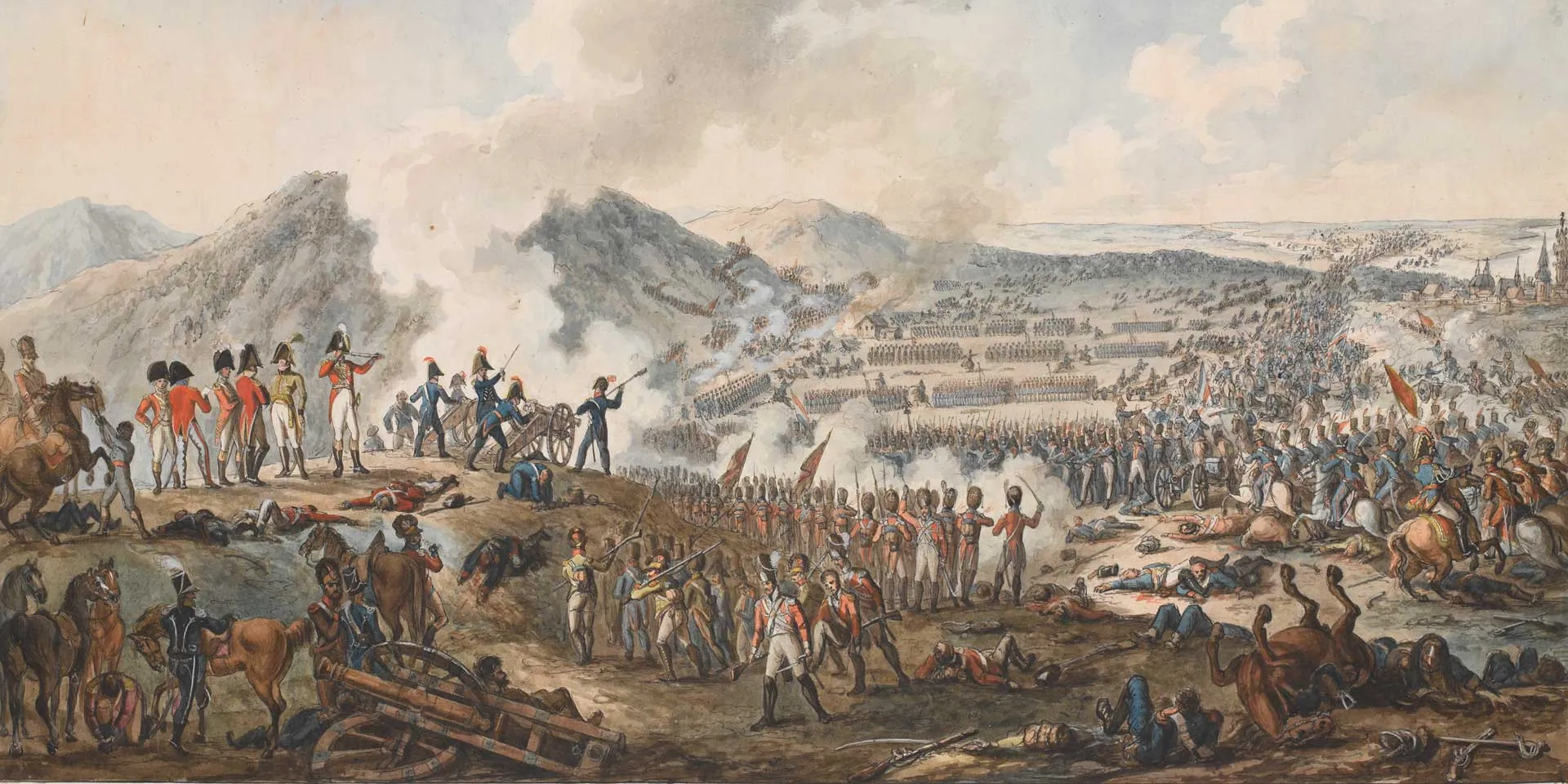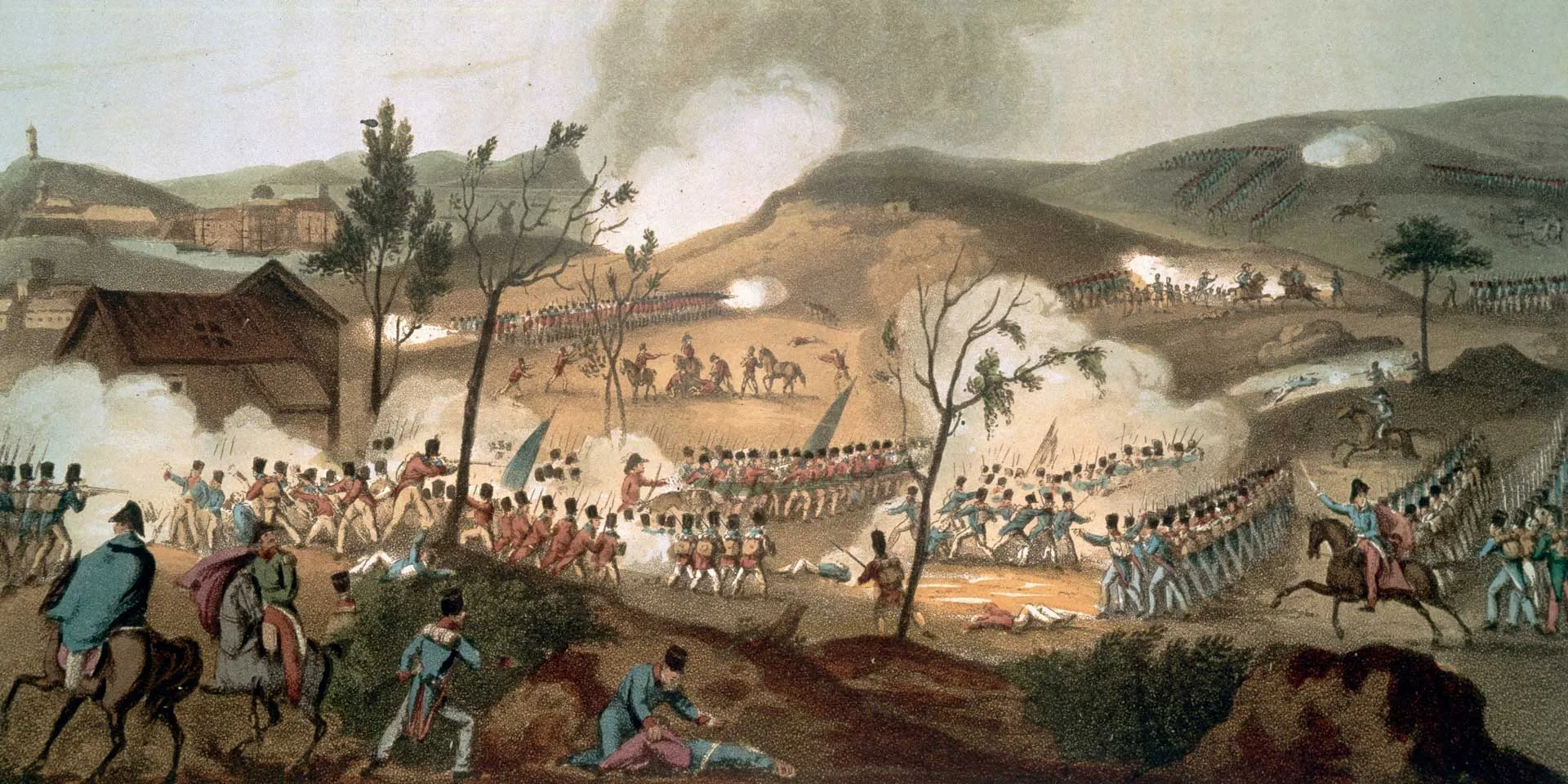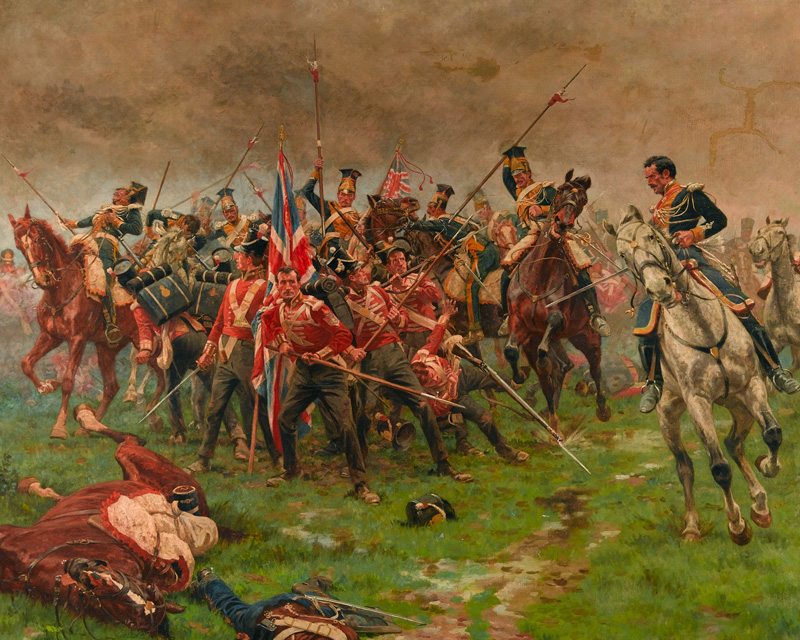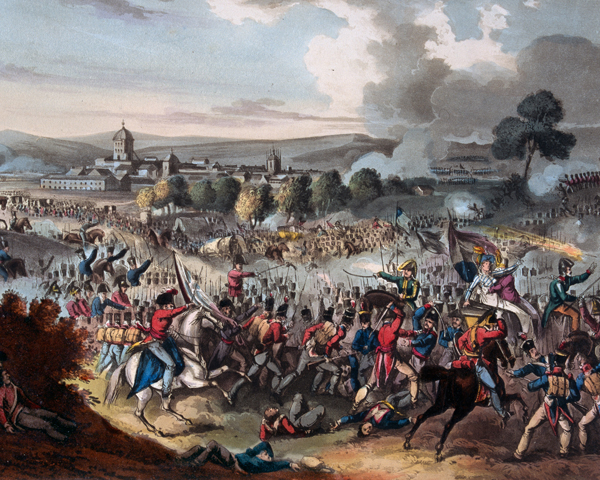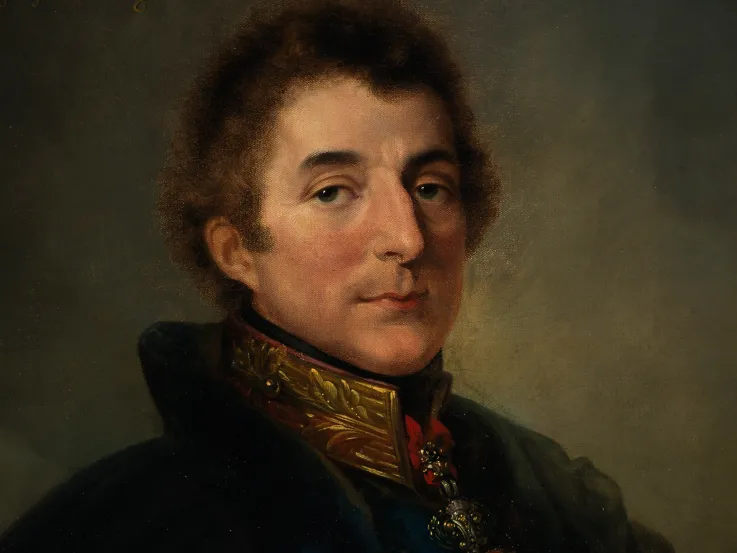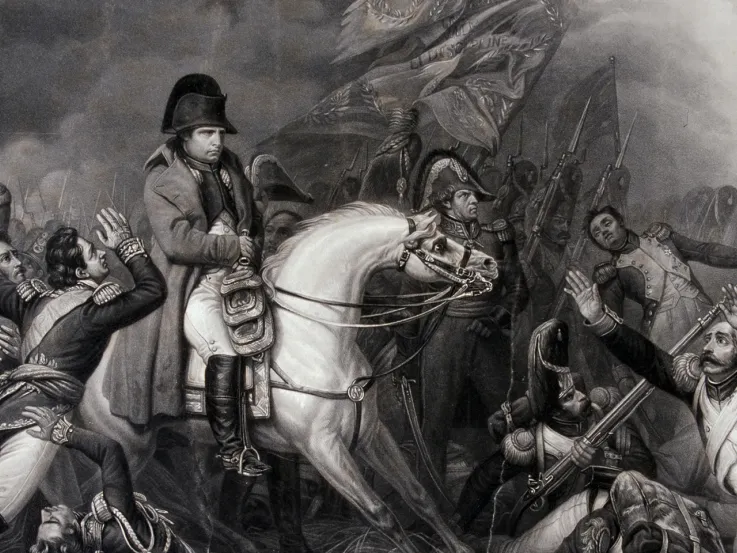Invasion
By 1806, the French had achieved dominance in mainland Europe. Their emperor, Napoleon Bonaparte, decided to combat Britain's ongoing opposition by attacking its economy and forcing the nations of continental Europe to close their ports to British goods.
The Portuguese, however, continued to trade with Britain. So, in November 1807, a French army marched through Spain and occupied the Portuguese capital, Lisbon.
Napoleon then turned his attention on Spain, previously an ally of France. In February 1808, French troops invaded the country and soon occupied Madrid. In May, Napoleon installed his brother Joseph as King of Spain.
Revolt
As the Spanish rose up against the French, Napoleon ordered his columns to quickly pacify the major centres of resistance. But the surrender of around 12,000 of his troops following their defeat at Bailén (16-19 July 1808) meant that he had to abandon much of Spain to the insurgents.
This battle was the first setback for the hitherto unbeatable French armies, and emboldened people in Iberia, and elsewhere, to resist.
The Spanish now appealed to Britain for help. In August 1808, 14,000 British troops landed at Mondego Bay in Portugal under the command of Lieutenant-General Sir Arthur Wellesley (later the Duke of Wellington).
On 17 August, the British fought their first battle of the Peninsular War at Rolica, defeating a smaller French force sent to slow Wellesley's advance towards Lisbon.
Vimeiro and Cintra
On 21 August 1808, Wellesley defeated the French at Vimeiro near Lisbon. However, he was immediately superseded in command by Generals Sir Harry Burrard and Sir Hew Dalrymple, and was unable to press home his advantage.
These new leaders concluded the Convention of Cintra, which achieved the overall British aim of clearing the French out of Portugal. But the terms of this agreement caused uproar back in Britain owing to the fact that the evacuation was carried out in British ships with the French allowed to take all their plunder with them.
The British commanders were ordered home to face an inquiry and Lieutenant-General Sir John Moore took over command of the army.
The ‘Spanish Ulcer’
The Portuguese and Spanish played an important part in the war. Retrained and reorganised by Marshal William Beresford, Portugal’s soldiers fought bravely alongside those of Britain. The stubborn Spanish defence of cities and towns tied down thousands of French troops. Spanish armies, though frequently defeated, kept reappearing, forcing France to send more armies against them.
French troops were also required to garrison hostile territory and wage a bitter war against Spanish and Portuguese insurgents, the ‘guerrillas’. French communications and supply lines were harassed by their raids and ambushes. By 1812, the French had over 350,000 soldiers in Iberia, but 200,000 were protecting lines of supply rather than serving as front-line troops.
All of these factors meant that although on paper the French heavily outnumbered the British armies in Iberia, they were never able to concentrate enough of their troops to win a decisive victory. The continual drain on French resources led Napoleon to call the conflict the ‘Spanish Ulcer’.
Corunna
Attempting to co-operate with the Spanish, Moore advanced into Spain with 35,000 men. But when he discovered that Napoleon himself had entered the country with a large army, and that Madrid had fallen to the French, he was forced to retreat. In terrible winter conditions, his army fell back to the north-west coast of Spain where the Royal Navy could evacuate them.
On 16 January 1809, the British fought off their pursuers at La Corunna. Although Moore himself was mortally wounded, the remainder of his force was successfully embarked. Moore’s army had been severely mauled, but it had at least drawn the French away from Portugal. And Wellesley, newly exonerated from blame by the Cintra Inquiry, returned to take command there.
‘Our bugles sounded the advance; away went the kettle; the word was given “Rifles in front extend by files in chain order!” The enemy’s sharpshooters were double and triple our numbers. We got within range and began to pick them off. We held them in check until our light division formed in line, and then the carnage commenced.’Bugler William Green, 95th Rifles, recalling the Battle of Corunna — 1809
Oporto
In March 1809, Marshal Soult invaded Portugal again, quickly defeating the Portuguese and capturing Oporto. Wellesley’s British troops, reinforced by Beresford’s new Portuguese units, then surprised Soult at Oporto (12 May) and drove the French back out of the country.
Talavera
Wellesley advanced into Spain and linked up with a Spanish army under General de la Cuesta. On 27-28 July 1809, they defeated the French at Talavera to the south-west of Madrid. This was one of the bloodiest battles of the war, with over 14,000 casualties. Wellesley was created Viscount Wellington following his victory.
Although the French withdrew from the field, Wellesley was forced to return with his force to Portugal after another French army under Marshal Soult threatened his lines of communication. Further operations were also restricted by the lack of co-operation between the British and their Spanish allies.
Torres Vedras
In preparation for another French invasion of Portugal, Wellington ordered the construction of a series of defences around Lisbon, known as the Lines of Torres Vedras.
In 1810, a large French army under Marshal Masséna captured the border fortresses of Ciudad Rodrigo and Almeida, and advanced into Portugal. On 27 September, Wellington’s Anglo-Portuguese army checked them at Busaco. The French were driven off with the loss of 4,500 killed or wounded, compared to Anglo-Portuguese losses of about 1,250.
Wellington’s men then fell back behind the Lines of Torres Vedras. These defences were strengthened by a scorched earth policy to their north, which destroyed food stores and anything else useful to the French.
Wellington’s position was clearly impregnable. But it took Masséna six months, and the starvation of 25,000 of his men, before he decided to retreat.
‘Instead of the “undulating accessible plateau” that we had been told to expect, we saw steeply scarped mountains and deep ravines, a road-passage only a few paces broad, and on each side walls of rock crowned with everything that could be accomplished in the way of field fortifications garnished with artillery; then at last it was plainly demonstrated to us that we could not attack the Lines with the 36,000 men that still remained of the army. For, even if we had forced some point of the Lines, we should not have had enough men left to seize and occupy Lisbon.’Colonel Jean-Jaques Pelet, Marshal Masséna's aide-de-camp — 1811
Cádiz and Barrosa
In February-March 1811, an Anglo-Iberian force tried to break the French blockade of the vital southern Spanish port of Cádiz. On 5 March, the French under Marshal Victor attacked this relief force near Barrosa.
Following a fierce battle on two fronts, the Allies succeeded in routing Victor's army. However, they were unable to lift the siege of Cádiz.
Almeida and Fuentes d’Onoro
In March and April, there was fighting along the Portuguese-Spanish border as Wellington tried to take back the fortresses of Almeida and Badajoz.
In early May, Masséna attempted to relieve Almeida with a reorganised army, but was narrowly defeated by Wellington at Fuentes d’Onoro (3-5 May). Although the French eventually abandoned the fortress, most of their men escaped.
Albuera and Badajoz
Further south, Marshal Soult set out to relieve the town of Badajoz, which was besieged by an army under Beresford. On 16 May, Soult outmanoeuvred his opponent at nearby Albuera. In a particularly bloody battle, Beresford was only saved from defeat by the dogged determination of his British infantry.
Three days later, Badajoz was besieged once more, this time by Wellington who had marched from Almeida. Had he possessed an adequate siege train and experienced military engineers, Wellington could probably have captured Badajoz fairly quickly. But his two assaults against the town's forts on 6 and 9 June were beaten back. Soon after, as French reinforcements approached, he was forced to abandon the siege.
‘Our poor fellows dropped around us in every direction. In the activity of the officers to keep the men firm, and to supply them with ammunition of the fallen, you could scarcely avoid treading on the dying and the dead. But all was firm... Tho' alone, our fire never slackened, nor were the men in the least disheartened... Our colonel, major, every captain and 11 subalterns fell; our King's Colours were cut in two, our regimental ones had 17 balls through them.’Ensign Benjamin Hobhouse, 57th (West Middlesex) Regiment, at Albuera — 1811
New offensive
As French troops were withdrawn from Spain to take part in Napoleon’s invasion of Russia, Wellington felt ready at last to take the offensive.
In early 1812, before the French could concentrate enough relief troops, Wellington attacked the border fortresses of Ciudad Rodrigo and Badajoz. Success at each would open up the northern and southern routes into Spain.
Ciudad Rodrigo
On 8 January 1812, he laid siege to Ciudad Rodrigo. By 19 January, his guns had opened up two gaps in the town's defences. That night, the 3rd Division attacked one breach, while the Light Division assaulted the other.
The 3rd Division suffered heavily from a huge mine explosion. But the Light Division forced its way into the town, while other troops succeeded in scaling the walls elsewhere. Attacked from all sides, the French surrendered.
Badajoz
After a lengthy bombardment to breach Badajoz's thick walls, an attack by escalade (scaling the walls on ladders) was launched on 6 April 1812. Wellington’s army sustained over 4,500 casualties storming the breaches.
Angered at the heavy losses they had suffered, the troops broke into houses and stores consuming alcohol and then going on a rampage of rape and pillage. Threatening their officers and ignoring their commands to desist, the soldiers massacred hundreds of civilians. It took three days before they were brought to order.
‘In a short time after the entrance of the Allied troops into Badajoz the whole of the British and Portuguese soldiers appeared to be in a state of maddened drunkeness for they had broken into the French store of wine and brandy in the vaults of the cathedral and many private stores besides. They scattered over the town divided into small parties plundering the houses, the doors of which they forced open... In passing several houses we heard the shrieks of females mixed with the groans of the dying; and when we met British and Portuguese soldiers in the streets, the insanity of the hour overcame the strong instincts and discipline and respect for their officers. In one street I met General Phillipon the French governor of Badajoz between his two daughters, holding each by the hand, and endeavouring to convey them out of the town... Two British officers with drawn swords escorted them, and had some difficulty in making their way through the drunken ruffians who sought to do them violence.’Surgeon General Sir James McGrigor — 1812
Salamanca
Having secured the Portuguese-Spanish frontier, Wellington advanced further into Spain. On 22 July 1812, his British, Spanish and Portuguese army defeated the French under Marshal Marmont at Salamanca. The victory was one of Wellington's finest, proving that he was more than just a good defensive general.
Wellington’s army of 48,600 suffered 5,200 casualties. But it inflicted around 14,000 casualties on Marmont's 50,000-strong force. Following the victory, Wellington was able to liberate Madrid (12 August) before moving north to besiege Burgos.
French response
These events undermined Joseph Bonaparte’s authority in Spain and encouraged the local guerrillas to increase their operations against French garrisons. The victory also forced the French to retreat from Cádiz and Andalusia in the south, as they risked being cut off.
However, they still had enough troops in north and eastern Spain to launch a major counter-offensive. Threatened with encirclement, Wellington was obliged to abandon the Siege of Burgos in October 1812 and retreat back into Portugal once again.
Supply lines
In 1813, Wellington advanced again, with 120,000 British, Spanish and Portuguese soldiers. Since he would be lengthening his lines of communication, he switched his supply bases from Portugal to the northern coast of Spain; a move made possible by the Royal Navy’s dominance at sea.
While the French lived off the land - a policy which angered the Spanish and strengthened support for the guerrillas - Wellington tried to ensure that his troops were properly supplied, and always insisted on paying for what he took from the locals. Despite this, plundering remained a constant disciplinary issue in his army.
Vitoria
After quickly taking Burgos on 21 June 1813, Wellington caught up with the French at Vitoria and defeated them in an enveloping attack. About 5,000 French soldiers were killed or wounded and 3,000 taken prisoner. Joseph Bonaparte himself narrowly escaped capture. Wellington’s force suffered about 5,000 killed or wounded.
The victory would have been even more decisive had many of Wellington’s troops not broken off the pursuit to plunder the French baggage. The victory at Vitoria effectively ended French control in Spain. It also encouraged the Austrians to re-join the coalition against Napoleon.
French in retreat elsewhere
Prussia and Sweden had also re-joined the struggle against France in early 1813, following Napoleon’s disastrous retreat from Moscow. Weakened French armies were now slowly forced back across central Europe towards the borders of France by the combined Russian, Austrian, Swedish and Prussian forces.
Napoleon was again forced to withdraw soldiers from the Peninsula to help shore up his crumbling position east of the Rhine.
Struggle in the Pyrenees
After Vitoria, Wellington’s army regrouped and pursued the retreating French, reaching the Pyrenees in early July. But on 25 July, Marshal Soult launched a large-scale counter-attack, hoping to relieve French garrisons at Pamplona and San Sebastian, which been surrounded by Wellington’s soldiers during their initial advance.
Following early success in the passes of Maya and Roncesvalles, the offensive ground to a halt in the face of increased resistance, including at the Battle of Sorauren (28 July), where the Anglo-Portuguese held off Soult’s drive on Pamplona. Soult abandoned the offensive on 30 July and withdrew toward France, having failed to relieve either garrison.
Wellington took San Sebastian in September 1813 after a two-month siege. The town was subsequently ransacked, and many civilians killed. Finally, the French garrison of Pamplona was starved into submission in October 1813.
Unable to get sufficient support from a weakened Napoleon, Marshal Soult led his exhausted and demoralised forces in a withdrawal across the Pyrenees and back into France, fighting battles at the Bidassoa (7 October), Nivelle (10 November) and the Nive (9-13 December).
Invasions
Meanwhile, having won the decisive Battle of Leipzig (16-19 October 1813), the Allies were advancing through the German states of central Europe. Most of these had been French client states, providing troops for Napoleon’s armies. But they now abandoned him.
In December 1813 and January 1814, three separate Allied armies invaded northern and eastern France. At the same time, Wellington resumed his offensive into southern France, defeating Marshal Soult at Orthes (27 February) before capturing Toulouse on 10 April.
Victory
Two days later, Wellington received the news that Paris had fallen to the Allies and that Napoleon had abdicated. The former emperor was subsequently exiled to the Mediterranean island of Elba.
Wellington immediately set about arranging a ceasefire with Soult, which came into effect on 18 April. This was too late to prevent the last major action of the war from occurring on 14 April, when the French garrison of Bayonne attacked the Anglo-Portuguese lines surrounding the city.
On 3 May 1814, Wellington - now a national hero - was made a duke. The Peace of Paris brought a formal end to the war on 30 May.
‘The most complete machine’
The campaign in the Peninsula had been the British Army’s main contribution to the war against Napoleon. By 1814, Wellington’s British contingent was 70,000-strong and had won a formidable reputation, particularly the infantry. Their ability to deliver a well-timed volley, and follow it up with a bayonet charge, gained them victory after victory over the French.
In 1813, towards the end of the war, Wellington commented that his army was ‘the most complete machine for its numbers now existing in Europe’. Unfortunately for the Duke, only parts of this experienced fighting force would be available to him when he faced Napoleon again in 1815 at Waterloo.

